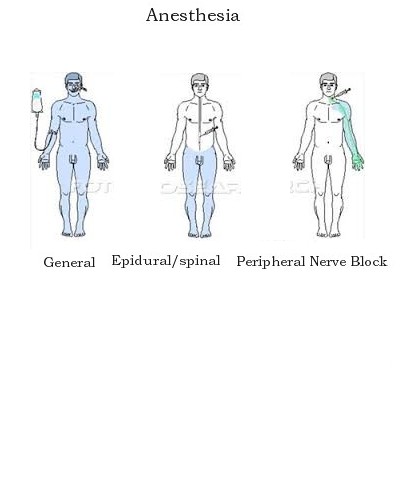Types of Anesthesia
General Anesthesia
A drug-induced complete loss of consciousness
Blocks the physiologic and conscious response to any painful or unpleasant stimulus.
Requires the anesthesia team to carefully monitor your breathing and overall safety.
Initiated with an “induction agent” (such as propofol or sodium thiopental)
Maintained by careful use of an anesthetic gas (isoflurane, desflurane, sevoflurane or nitrous oxide) administered through an endotracheal tube.
Regional anesthesia
Except GA all the others are regional anesthesia
Uses local anesthetic drugs, such as lidocaine, to block painful sensations in a certain part of your body.
There will be loss of sensation and motor control.
Relaxation of the muscles.
Regional anesthesia is almost always supplemented with sedation to enhance comfort and reduce anxiety;
Patients who receive regional anesthesia are completely unaware of their surroundings.
Regional anesthesia can be administered in several ways.
Spinal Anesthesia
Involves an injection of local anesthetics into the spinal fluid
Numbness in the abdomen and lower body.
It is effective for certain abdominal, pelvic and lower extremity procedures.
Can last for one to six hours.
Safe but may be associated with low blood pressure
spinal headache may occur
Epidural anesthesia
Involves an injection of local anesthetics and painkillers into the space between the spinal canal and the dura mater.
Involves placement of an epidural catheter that can also be used for postoperative pain relief.
Epidural catheter may remain in place for up to five days following surgery and periodically anesthetics are administered for control of post-op pain
Side effects of spinal anesthesia such as low blood pressure and itching are least
Peripheral nerve blocks
Blocks all sensation in a prticular nerve distribution
Nerve blocks can be used for surgical anesthesia and for postoperative pain relief.
e.g. : - Brachial block, axillary block, pudendal block, wrist block
Heavy sedation or monitored anesthesia care (MAC)
Blunting of consciousness that can provide comfort during unpleasant procedures.
To avoid possible respiratory and cardiac depression, it requires close and careful monitoring
Awareness of your surroundings during MAC is very unlikely but possible and is not considered a failure of the technique.
Local anesthesia
Is an injection intended for small region of the body.
For simple procedures and does not require involvement of the anesthesia care team.
Many local anesthesia procedures are
performed in the doctor’s office.




